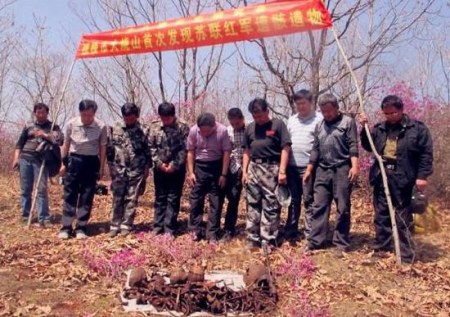
Remains of Russian soldiers' remains were found in 1992.
A Sino-Russian project to locate the remains of Russian soldiers who fell in northeast China's Heilongjiang Province while helping defend China against Japanese invaders in 1945 has identified at least 15 burial sites.
The Soviet Red Army sent troops to northeast China on Aug. 9, 1945. A total of 413 Soviet soldiers died during the Battle of Huoshao Mountain in Heilongjiang's Muling City.
The search for their remains on Huoshao Mountain and the surrounding villages is one of many activities marking the 70th anniversary of the Allies' victory in World War II this year.
During a preliminary survey, which took about 10 days and concluded on Thursday with the six Russian experts leaving Heilongjiang, the team found 10 pieces of bone that they suspect are from Soviet soldiers. They also discovered bullets, mortar parts and boots worn by the Japanese.
A more thorough follow-up search, which will last a month, will start on May 10. It will involve a 17-member Russian team, and tentative plans are under discussion over whether the remains will be sent back to Russia or housed in a new memorial cemetery on the site.
FIERCE BATTLE
Seniors living around Huoshao Mountain still recall what happened in the fierce battle there 70 years ago.
Ji Yaozong was 12 in 1945. He remembers seeing Japanese soldiers painting power line poles green to disguise them as military hardware.
"They did it pretend they had ample weapons," Ji said.
Before the Soviet soldiers came, Ji's father walked 8 km to buy food to sustain them while they hid on the mountainside.
Ji can still remember the sound of bombs falling from the sky while he was hiding in an air-raid shelter.
The air raids ignited fires that burned for days, which is where Huoshao got its name, which means "fire burning" in Chinese.
Zhang Ke was eight at the time of the battle. Five months later, he went to Hualin Village near the mountain and saw bodies half buried in snow.
"The bodies were piled on top of each other," he recalled. "The Japanese wore caps with earflaps, while the Soviet soldiers wore steel helmets."
Even after several years, Ji Yaozong said bones were still scattered around the mountain.
"I got used to seeing them. I was not scared by it," he said.
REMEMBRANCE
It is these remains that the Sino-Russian team has been uncovering over the past 10 days. They used colored flags to differentiate the remains -- blue for those of Japanese soldiers and red for those of Soviets.
One grizzly find was the remains of four Soviet soldiers who were clustered together by their weapons and breastplates.
They were soldiers from the 65th Infantry of the Soviet Red Army's No. 5 group.
"They were lying close together, in an orderly fashion," said Liu Guanglin, a farmer in Muling who found the remains. "The skeletons still had their helmets on, while a metal plate bore Russian letters." He also found cutlery.
"For 70 years, the final resting place of these soldiers was an obscure place that their families hadn't even heard of," said Roman Chukmasov, deputy head of the Russian team. "We are trying to preserve our collective memory of when we helped the Chinese drive the Japanese out of the northeast. We want to let our people know what happened 70 years ago on this land."
From where they were staying, it took the team an arduous two-hour walk, laden with spades and drills, to reach the search sites. While searching, the team had to watch out for undetonated bombs.
However, for Chukmasov, it was worth it. "The search itself is meaningful enough," he said. "We have been able to touch history with our own hands."
















































